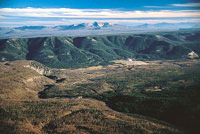March 19, 2006

Recently discovered changes in Yellowstone National Park’s crater (or caldera) are the result of molten rock movement 15 kilometers below the Earth’s surface, according to research conducted by U.S. Geological Survey scientists using images acquired by the European Space Agency’s ERS-2 satellite.
Calderas are created when a volcano explodes then collapses into a depression, or when a volcanic cone collapses. It is believed that about 640,000 years ago (during the Pleistocene epoch), a massive volcano erupted in what is now Yellowstone National Park, creating the caldera in the center of the park. Yellowstone’s Pleistocene caldera-forming explosive eruptions, according to the Yellowstone-Teton Epicenter (a project of the Yellowstone Observatory), dwarfed the 1980 Mt. St. Helens and 1991 Mt. Pinatubo Philippines eruptions. (The group also noted on its Web site that beneath the Yellowstone region lies the largest active magmatic [molten rock] system in North America.)
In 1997, according to ESA, it was observed that the northern rim of the caldera began rising — an event known as the North Rim Uplift Anomaly (NUA). At the same time, the floor of the caldera began sinking. The floor sank as molten rock or magma flowed out of the caldera into the Yellowstone volcanic system.
The uplift of the caldera’s rim is thought to have occurred even as the floor sank because one of the natural “valves,” which allow the magma to enter into the volcanic system, was unable to accommodate the increased flow of magma, causing it to accumulate beneath the north caldera boundary.
The magma movement may have also triggered the sudden rise in temperatures at the Norris Geyser Basin and the eruption of the Steamboat Geyser in 2000. The world’s largest geyser, Steamboat had been inactive for nine years, but erupted five times between 2000 and 2003.
Using Synthetic Aperture Radar Interferometry (aka InSAR), Charles Wicks, Wayne Thatcher and other USGS scientists mapped the changes in the northern rim of the Yellowstone caldera and determined it had risen about 13 centimeters from 1997 to 2003.
InSAR mathematically combines different radar images, acquired from as near as possible to the same point in space at different times, to create digital elevation models and reveal otherwise undetectable changes occurring between image acquisitions, according to ESA.
“We know now how mobile and restless the Yellowstone caldera actually is,” said Thatcher. “Ground-based measurements can be more efficiently deployed because of our work. The research could not have been done without satellite radar data.”
The disturbances in the Steamboat Geyser from 1997-2003 are not unique in Yellowstone’s history, but, as the scientists noted, this is the first time the changes in the deformation field in the park suggested a cause-and-effect relationship — determined by analysis of the InSAR data.
Despite the activity in the caldera, Thatcher said the likelihood for a magmatic eruption is extremely low. However, the area poses other potential risks.
“The possibility of a steam-water explosion (‘Phreatic eruption’) is perhaps the greatest risk,” said Thatcher. “Its effects would be quite local, but still potentially dangerous.”
ESA has accumulated a 15-year archive of homogenous data due to the continuity of satellites ERS-1, ERS-2 and Envisat. Envisat and ERS-2, with a difference in overpass time of 30 minutes, are adding to the archive. This data helps to identify and analyze long-term trends and changes, according to ESA.
“The complete aerial coverage and frequent repeat satellite passes creates a unique suite of deformation measurements of restless volcanoes worldwide,” said Thatcher. “They are particularly useful in remote and inaccessible areas. We will continue to monitor Yellowstone with InSAR imaging.”
The scientists’ findings were published in the March 2, 2006 issue of Nature.
Sources: European Space Agency, Yellowstone-Teton Epicenter.
Photo courtesy of Smith, R. B. and Siegel, L. – Windows Into The Earth, The Geologic Story of Yellowstone and Grand Teton National Parks – Oxford University Press, 2000.